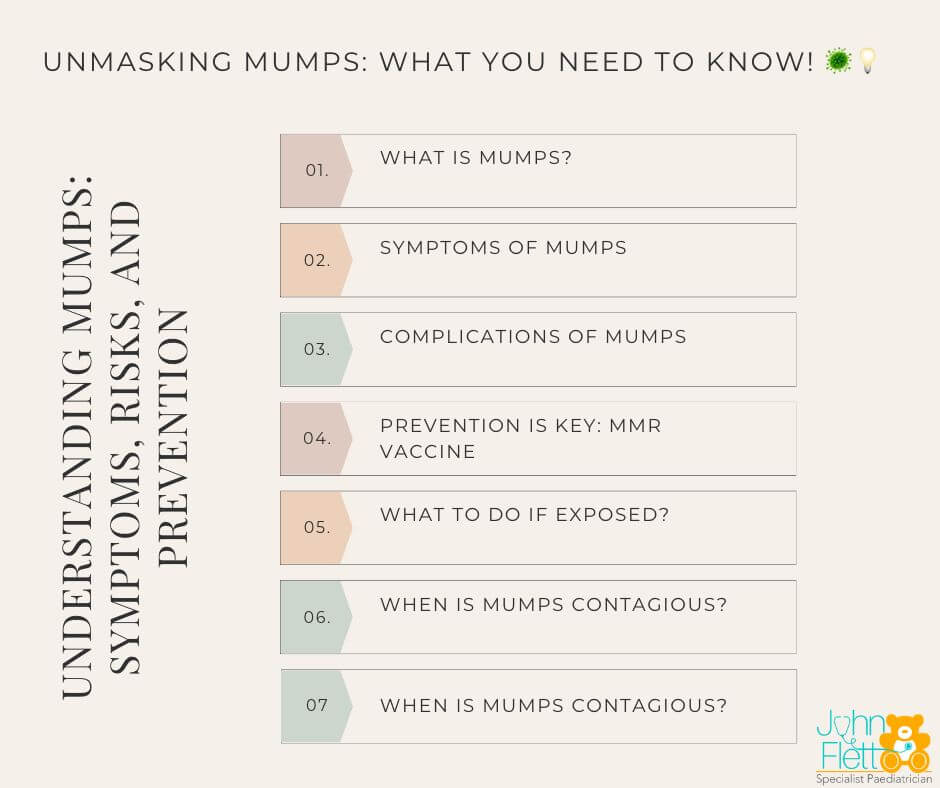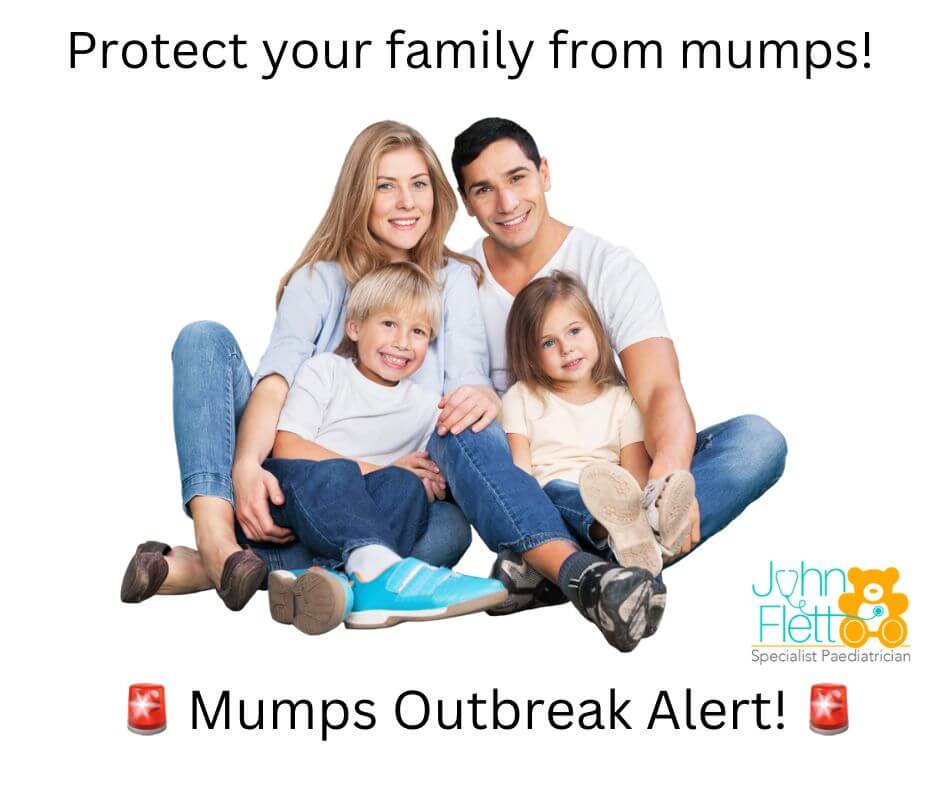Understanding Mumps: Symptoms, Risks, and Prevention

Mumps is a contagious viral infection that is known for its hallmark symptom: painful swelling of the salivary glands, specifically the parotid glands, which results in a characteristic puffy-cheeked appearance. Mumps used to be quite common before the introduction of the mumps vaccine as a part of the MMR (measles, mumps, and rubella) immunisation programme. Although the incidence of mumps has dramatically decreased, outbreaks can still occur, especially in close-contact settings like schools and childcare centres.
What to do if Your Child is Exposed to Mumps
If your child has been exposed to mumps, the first and most important step is to check their vaccination status. The MMR vaccine, administered in two doses in early childhood, offers valuable protection against mumps. Even if exposure has occurred, a fully vaccinated child is significantly less likely to contract the illness.
Following exposure, watch for symptoms during the incubation period, which typically lasts 16 to 18 days but can range from 12 to 25 days. The most common symptoms include fever, headache, muscle aches, fatigue, loss of appetite, and swollen and tender salivary glands under the ears or jaw on one or both sides of the face.
It’s important to note that mumps can start with swelling on one side of the face, and then, after a week or two, the other side can become affected.
In the event that symptoms of mumps do occur, consult with a healthcare professional promptly. They can confirm the diagnosis and provide guidance on care and isolation to prevent spreading the virus.
Potential Complications and Care
While most cases of mumps are relatively mild, the disease can occasionally lead to serious complications, especially in older children and adults. These may include:
- Encephalitis or Meningitis: Inflammation of the brain or the tissue covering the brain and spinal cord respectively. These are rare but can be life-threatening if not treated promptly.
- Hearing Loss: Mumps can result in hearing loss, typically in one ear. In most cases, this is temporary, but in rare instances, it can be permanent.
- Orchitis and Oophoritis: In adolescent boys and men, mumps can cause painful swelling of the testicles, and in adolescent girls and women, it can lead to ovarian inflammation. While these conditions are usually temporary, they can occasionally lead to fertility issues in the long term.
- Pancreatitis: This condition is characterised by inflammation of the pancreas, resulting in abdominal pain and vomiting.
The contagious period for mumps typically begins about 2 to 3 days before the onset of face swelling and continues until about five days after the swelling begins. Therefore, isolation of individuals diagnosed with mumps is crucial to prevent the virus from spreading.
After an episode of mumps, it’s generally advised that children stay away from school for at least 5 days after the onset of parotid gland swelling. However, it’s essential to consult with your healthcare provider, who can give the most accurate advice based on your child’s specific situation and the current guidelines of public health authorities.
In conclusion, mumps can lead to serious complications, but these are less likely with the protection offered by the MMR vaccine. Prompt attention to symptoms, swift diagnosis, and adherence to isolation guidelines can also significantly minimise the risk of complications and the spread of the disease. Vaccination remains the most effective way to prevent mumps, and it’s essential to ensure your child is up to date with their immunisations.
The MMR vaccine, which protects against measles, mumps, and rubella, is typically given in two doses to children as part of their routine immunization schedule.
The Centers for Disease Control and Prevention (CDC) recommends the following schedule for MMR vaccination:
- The first dose is typically given at 12 to 15 months of age. This dose provides initial protection against the three viruses.
- The second dose is generally given between 4 to 6 years of age, before a child enters school. However, it can be given earlier as long as there is a gap of at least 28 days from the first dose. This second dose serves to strengthen the child’s immunity.
The two-dose MMR vaccination series provides immunity to about 97% of individuals against measles and mumps and about 88% against rubella.
MMR Vaccination in Adulthood
For adults who have not been vaccinated, or for those who cannot confirm their vaccination status, MMR vaccination is recommended, particularly for those at higher risk. High-risk individuals include college students, healthcare workers, international travelers, and those who might be in an outbreak setting.
Specifically, adults born after 1956 should have documentation of at least one dose of MMR vaccine or evidence of immunity to these diseases from a lab test. Certain adults at high risk, such as healthcare workers and international travelers, should have documentation of two doses of MMR vaccine, spaced at least 28 days apart.
Women of childbearing age should ensure they are vaccinated against rubella, as it can cause severe birth defects if contracted during pregnancy. They should avoid becoming pregnant for at least one month following each MMR vaccination.
It’s crucial to consult a healthcare provider to understand the appropriate vaccination schedule based on individual health history and risks. Pregnant women and individuals with certain health conditions might be advised not to get the MMR vaccine. Always consult with a healthcare professional for personalized advice.
- What is Mumps?
- Mumps is a highly contagious viral disease that was common before the introduction of the MMR vaccine.
- Symptoms of Mumps
- Common symptoms include fever, headache, muscle aches, tiredness, loss of appetite, and the characteristic swelling of the salivary glands, resulting in a tender, swollen jaw.
- Complications of Mumps
- While mumps is often mild, complications can occur, including meningitis (an infection of the covering of the brain and spinal cord), orchitis (swelling of the testicles in males who have reached puberty), oophoritis (swelling of the ovaries in females who have reached puberty), pancreatitis (swelling of the pancreas), and deafness.
- Prevention is Key: MMR Vaccine
- The best protection against mumps is the MMR (measles-mumps-rubella) vaccine. It’s usually given in two doses, first at 12-15 months of age and again at 4-6 years. Adults who are unsure of their vaccination status should consult their healthcare provider.
- What to Do If Exposed?
If you or your child are exposed to mumps, contact your healthcare provider immediately. Keep a close watch for symptoms for 12 to 25 days after exposure. If symptoms do appear, isolation is necessary to prevent the spread of the virus.
- When is Mumps Contagious?
- Mumps is contagious from 2-3 days before the swelling of the face until five days after the swelling begins.
- Return to School
Children with mumps should stay home from school for at least five days after the swelling begins to prevent the spreading the virus to others.


Responses